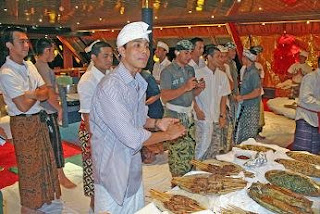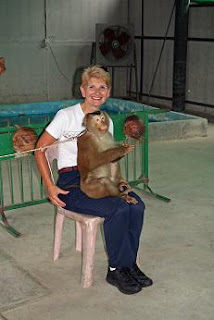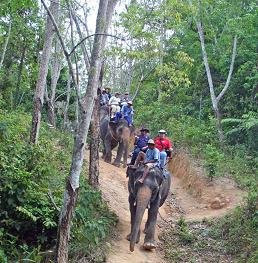

























Heavy traffic swims through the Straits of Malacca . . .
. . . one of the world’s busiest waterways . . .
. . . brimming with tankers, cargo ships, and even cruise ships.
Squeekie looks over our verandah rail . . .
. . . at the lovely sunset in the straits.
Rotterdam docks at Phuket early on Wednesday morning—Thailand awaits!
There is evidence of the environmental damage done in the mining of tin
On our drive into the island’s interior, we saw evidence of Thailand’s westernization . . .
. . . but there still are new buildings being built to traditional Thai architectural designs
. . . and most Thai houses still have these small spirit houses nearby.
We passed a store selling spirit houses.
Squeekie and Moss aboard an elephant, ready for a ride through the jungle
This is our caravan in the jungle, looking forward . . .
. . . and looking backward.
Squeekie got to rub the trunk of a baby elephant . . .
. . . and sit with a monkey . . .
. . . and ride on a water buffalo.
The baby elephant could paint after a fashion . . .
. . . and he waved at the camera.
Moss also helped the monkey to ride a bicycle.
Rotterdam docked at Phuket
The Balinese dining room crew invited Moss to attend their festival . . .
. . . there was prayer . . .
. . . and feasting . . .
. . . and more feasting.
Moss was welcomed and a good time was had by all
Fifty-seventh day (Tuesday, March 17, 2009)-- Today was a special at sea day because Rotterdam was traveling through one of the busiest, most-traveled sea lanes in the entire world, the historic straits of Malacca. This is the narrow waterway between the Malay Peninsula on the east and the large island of Sumatra on the west. This 500-mile (805 km) long waterway is the main shipping channel between the Indian Ocean and the Pacific Ocean, and as such it carries raw materials and fuels TO, and the finished products FROM the Asian economy. Over 50,000 ships pass through these straits each year—not counting the fishing fleets—carrying about twenty-five percent of the world’s traded goods, from oil and coffee to clothing and motor vehicles. Rotterdam’s course through this busy channel kept us within five to ten miles of land, and always with several other ships in sight. It was a fascinating day, as Squeekie and I sat up in the Crows Nest writing our journal and blog (and me sorting pictures, too), watching the other ships pass by, often quite close.
An historic note-- The Straits of Malacca are named for the port town of Malacca (originally Melakka) on the Malay Peninsula, which since ancient times had been a keystone in the international spice trade. The Portuguese arrived there in 1511 and established control; later the town came under Dutch rule, and finally the British colonized the area. The town gave its name both to the strait of water it faces and to the Malay state which backs it. Although later surpassed by Batavia (Jakarta) on the nearby island of Java, and by Singapore once that fishing village grew up, for many centuries (and well into the centuries of European control of the spice trade) Malacca was an important focal point of the flow of spices from the “Spice Islands” (now Indonesia) to customers from India to the Western world.
OK, back to our adventure-- This afternoon while she was doing her walk on the Lower Promenade Deck (Deck Three- three turns around the ship is one mile), Squeekie noticed some unusual activity; security officers were attentive at the aft of the ship and the fire hoses were stretched out on both sides of the ship. We later heard that this was a protective measure because there had been some reports of “pirate” (terrorist?) activity in the Straits. Perhaps it also was a practice session for later, when we must deal with the Somali “pirates” operating in the western portions of the Indian Ocean off the African coast.
The evening featured a big celebration of Saint Patrick’s Day, replete with decorations, dining, and dancing. As most of you know, I have no interest in this event as I am no great fan of the Irish, so I’ll just close this day here.
Fifty-eighth Day (Wednesday, March 18, 2009)-- Early this morning the Rotterdam docked in the Deep Sea Port on Phuket, an island at the southern tip of Thailand which in recent years has become a popular resort famous for its beaches. Squeekie was very excited to be here in a return to Thailand, and for the tour we had scheduled for the day, which included riding some elephants.
A bit of history-- Before we get to the elephants, however, let’s understand a little about the history of this interesting island. Phuket is Thailand’s largest and most populous island, 500 square miles of bays, beaches, limestone hillsides, forests, and—environmentally damaged land. Back in the mid-nineteenth century, the technology of canning food was just beginning—the first major canned food was beef. Food cans are made from sheet steel, of course, but it took a while to learn that sheet steel untreated in any way quickly rusts or corrodes, spoiling the canned product (it was spoiled canned beef that apparently poisoned and killed the Franklin expedition in the Canadian Arctic in the 1850s). To resolve this problem, it was quickly learned to coat the sheet steel with tin, but at the very moment the demand for tin increased, the famed tin mines of Cornwall ran out of this metal. Soon there was a world-wide search for new sources of tin. One source was in Malaya (one reason why the British moved in and took over that region), another source was Phuket Island in Thailand (or Siam as it was known in the nineteenth century). The problem with tin recovery in Phuket was that the tin there is alluvial in nature (like some of the gold in California at the same time), meaning that the tin is contained in various sediments washed down from the hillsides. To recover the tin, this tin-bearing ground had to be “washed,” and the most efficient way to do this was by the use of large dredges which floated in large self-made pools of water, scooping up the dirt, washing it, and depositing the tin-less waste muck out behind. (The Natomas Company recovered gold this way in California’s Sacramento Valley well into the 1960s). The problem with this technology was that it left behind large areas of washed-over ground studded with muck piles. It was very messy, and the results could still be seen in many of the areas through which we drove (and elephant trundled) on Phuket Island (see picture).
Now, on to the spirits and the elephants-- After breakfast (out on the back deck in the sunshine) we boarded the bus and headed away from the harbour; the deep sea port is some miles away from the town of Phuket, and we had to go through town and country to get to our destination. I was interested to see that Thai architecture, unique with its up-turned eaves, stilted platforms, and open sides is still widely preserved in Phuket despite the westernization of the island and all of Thailand.
Of special interest to me was the wide-spread existence of so-called “spirit houses,” little abodes which are replicas of Thai-style houses or temples and are placed on a property exclusively for the comfort of the guardian spirits who live on, and protect, that land and its residents. These little houses are very cute in design, and our tour bus even passed a store selling spirit houses (see picture). In Thailand, animism and astrology are intertwined with the philosophy of Buddhism, so much so that it is difficult for an outsider to separate them. One of many areas where this animism appears is with the spirit houses and the resident guardian spirit, whose powers are believed to be considerable. When the human resident encounters difficulties—perhaps servant problems, a burglary, or even a business problem—the cause is usually traced to spiritual dissatisfaction. Purchase of a new (spirit) house or the moving of that house to a different location on the property may bring an improvement. This sounds strange to Westerners, but these beliefs are very deeply rooted in Thailand.
After driving through Phuket and out into the countryside, where we did see evidence of tin mining damage, we arrived at the “Amazing Buket Safari,” where large elephants were in evidence. Thailand, as with all of Southeast Asia, had used elephants as heavy movers until quite recently, and this had contributed to the survival of the Asian elephant when many other animals had been exterminated. Once the Thai elephant could be seen dragging logs, pulling boulders, and lifting heavy objects, but this usage has just about died out in Thailand and the rest of Southeast Asia. Still, many elephants have been preserved for the tourist trade, and they do not appear to be in immediate danger of extinction.
Thanks to a raised platform construction, Squeekie and I were able to get right on the back of a large elephant whose name, we learned, was Mickey. We sat side-by-side some ten or eleven feet high in the air, feeling much above our normal positions, but when we went to buckle ourselves into the seat upon which we were placed, it wouldn’t lock. Now, I’m not surprised by this, after all, I am a large man. I am used to having to ask an airline stewardess for the “extender” in order to belt myself in to the airplane seat, but there was no such thing here, even though the belting apparatus was somewhat similar. I was concerned about this because it was a long way down to the ground, and there was a lot of elephant poop down there. Worse yet, I was concerned for the safety of my Squeekie. She had ridden an elephant once before in Thailand, when she had come with Iris Stuart in 2006, and she knew how unsteady it could be to ride atop these large lumbering creatures. She was worried, and asked our mahout (elephant driver) to fix the seatbelt. After some fiddling, the belt was latched, and we were ready to go off into the jungle. A long caravan of elephants lined up with three humans atop each animal (two tourists and the mahout). Just ahead of us were Wally and Brenda; he is on my trivia team on at sea days. We waved at them and they waved back as our beasts began to carry us—but just as we got going their elephant decided to relieve his colonic pressure right in front of us. As I watched, a huge, long column of greenish elephant dung poured out and down, and a less than lovely smell wafted back toward us. Welcome to the jungle!
Off we went, lumbering in time with Mickey. It was a wonderful feeling, not nearly as uncomfortable as riding atop a galloping horse, but just a gentle side to side lumber as the elephant made his way along the trail. Occasionally Mickey had to climb up a steep point in the path, or climb down, but it was not fearsome to us, even if the tip downward was momentarily a bit shakey. At one point in this journey the mahout got down with my camera and took a few pictures of Squeekie and I atop Mickey. It was a fun event. I never felt afraid for the animal (because of my weight), for it always seemed as though the elephant was taking an effortless walk through the jungle. Our trail passed through an area of rubber trees, a plantation once planted for the world rubber market which bloomed early in the twentieth century thanks in large part to the spread of the motor vehicle. At another place we had to cross a mini desert-like area where once tin mining had been done. After this very interesting, and all too short, journey through panoply of Thailand history, we returned to the camp, sidled up to the raised platform, and said good-bye to Mickey. It was fun and I will always remember that ride in the jungle.
The “Buket Safari” had other interesting exhibits as well. There was a talented and well-trained monkey named Diamond who rode a bike, picked coconuts, and demonstrated other powers for us; Squeekie even got to meet him up close. A baby elephant did some tricks and tried his hand—should I say trunk—at painting. Squeekie had a ride atop a water buffalo while I took her picture. Yes, we were genuine tourists, but it was fun!
All in all this was a very interesting tour. After the safari, we enjoyed a sampling of Thai cooking, and also visited a gem store where Squeekie found and purchased a black pearl similar to the one she had modeled aboard the Rotterdam some weeks ago. After returning to the Rotterdam, we visited the small shops which had been set up beside the dock, and we bought a carved teak elephant to help us remember this day. After a Thai menu in the dining room, Squeekie fell asleep on the bed still in her clothes, but I had to stay awake because yet another event awaited me this night.
Presti, our Dining Room Assistant Maiter’d, had invited Squeekie and I to come back to the dining room at 11:30 pm to join in a celebration being held by the Balinese crew of the Rotterdam. Squeek was out for the night, but I wanted to come and see them as they prayed and feasted to observe one of their most important holidays of the year. This event, known in the Balinese lunar calendar as Galungan is, we were later told by Presti, similar to Christmas to the Balinese people. So I came to the back of the downstairs dining room, took off my shoes and socks, sat down and watched (and, with permission, took a few pictures) of this event. One of the older Balinese crew members kneeled in the front and recited the prayers, which were picked up by the others in an almost musical chant. Incense sticks were lit and burned, and prayers continued. Then holy water was shaken over the group, individual prayers said, and then it was time to feast. Huge bowls of white and saffron yellow rice were brought out. Sticks of delicious pork and chicken were shared, and two small suckling pigs were carved. The food was shared out on the trays usually used to carry plates and silverware, but now became large platters themselves. The Balinese sat down in groups of six or so and reached in to grab the food. Yes, it was a traditional feast, with eating done by hand. Presti made a sweet mixture of cut fruit and canned milk which was delicious (and helped to cool my mouth from the rather spicy food being served). It was both delicious and special, and I remain grateful to Presti and all of the Balinese crew members, some of whom work elsewhere in the ship and I had not seen before, for inviting me to join in their special event. By this time Rotterdam was sailing west into the Indian Ocean, enroute to India, but I was glad—and honoured—to have been a part of this very special Southeast Asian celebration.
No comments:
Post a Comment